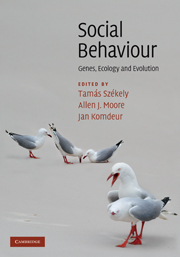Book contents
- Frontmatter
- Contents
- List of contributors
- Introduction: The uphill climb of sociobiology: towards a new synthesis
- Profile: Undiminished passion
- Part I Foundations
- Part II Themes
- Part III Implications
- 16 Personality and individual social specialisation
- Profile: Behavioural ecology, why do I love thee? Let me count the reasons
- 17 Molecular and genetic influences on the neural substrate of social cognition in humans
- Profile: Anonymous (and other) social experience and the evolution of cooperation by reciprocity
- 18 Population density, social behaviour and sex allocation
- Profile: Social theory based on natural selection
- 19 Social behaviour and speciation
- Profile: Look to the ants
- 20 Social behaviour in conservation
- Profile: The handicap principle and social behaviour
- 21 Prospects for research in social behaviour: systems biology meets behaviour
- Species index
- Subject index
- References
21 - Prospects for research in social behaviour: systems biology meets behaviour
Published online by Cambridge University Press: 05 June 2012
- Frontmatter
- Contents
- List of contributors
- Introduction: The uphill climb of sociobiology: towards a new synthesis
- Profile: Undiminished passion
- Part I Foundations
- Part II Themes
- Part III Implications
- 16 Personality and individual social specialisation
- Profile: Behavioural ecology, why do I love thee? Let me count the reasons
- 17 Molecular and genetic influences on the neural substrate of social cognition in humans
- Profile: Anonymous (and other) social experience and the evolution of cooperation by reciprocity
- 18 Population density, social behaviour and sex allocation
- Profile: Social theory based on natural selection
- 19 Social behaviour and speciation
- Profile: Look to the ants
- 20 Social behaviour in conservation
- Profile: The handicap principle and social behaviour
- 21 Prospects for research in social behaviour: systems biology meets behaviour
- Species index
- Subject index
- References
Summary
Overview
The study of social behaviour, often called sociobiology, is entering a new phase. A growing focus on mechanisms has enriched the older, evolutionary, perspective of sociobiology. The chapters in this book provide an overview of some of the most influential examples of research adopting the multifaceted approaches used to understand social evolution. There are top-down examinations of the way selection influences behaviour and, therefore, its neural and genetic structure, and bottom-up examinations of the genetic, hormonal or neurobiological substrates of behaviour. We therefore have a detailed understanding of the social, ecological, physiological, neurological, hormonal and genetic factors leading to complex social behaviour, but little integration. Picking apart the components and influences on behaviour is a reductionist approach, and although this has provided considerable insights we argue that it is now time for a synthetic perspective. We argue that a complementary perspective that unifies the particulate knowledge we have gained is now possible, and in keeping with current fashion we label this a systems biology approach to studying behavioural complexity. In reality, this is not new but a re-emphasis of the original synthetic view of sociobiology. Systems biology is simply a focus on interactions among components, and it works towards developing a predictive framework for resulting emergent properties of a system. Systems biology depends on a detailed understanding of the component parts to a system, and we believe this will be increasingly available for social behaviour, given the availability of new and less expensive approaches to gaining mechanistic information.
- Type
- Chapter
- Information
- Social BehaviourGenes, Ecology and Evolution, pp. 538 - 550Publisher: Cambridge University PressPrint publication year: 2010
References
- 2
- Cited by



